Lemna minor
Scientific name: Lemna minor
Family: Araceae
Maximum size reached under cultivation: 0 - 2 cm (0 - 0.79 inch)
0°C 32°F30°C 86°F
Recommended temperature range: 17 - 26 °C (62.6 - 78.8°F)
Preferred propagation method: Divisions
Native to: Cosmopolitan
Growth rate: Fast
Recommended substrate: Without substrate
Lighting requirements: Bright
Common Name
Common Duckweed
Origin
Lemna minor, commonly known as Common Duckweed, is a cosmopolitan plant found in freshwater environments worldwide. It thrives in still or slow-moving waters such as ponds, lakes, ditches, and marshes. Its wide distribution covers diverse climates, from temperate regions to tropical zones. In its natural habitat, Lemna minor floats freely on the water surface, forming dense mats that can quickly cover entire bodies of water under the right conditions.
Lighting Requirements
Lemna minor is highly adaptable to various lighting conditions. While it can grow under low-light environments, it thrives in moderate to bright lighting, where it can quickly spread across the water surface. However, it is essential to monitor its growth in brightly lit aquariums as excessive light combined with nutrients can cause it to proliferate, potentially blocking light from reaching submerged plants. Controlling the amount of light exposure and nutrient levels can help manage its growth rate, preventing it from becoming too invasive.
Propagation
This plant reproduces primarily through division, a process where each individual plant develops new leaves and then splits into two separate plants. This division happens rapidly, especially in nutrient-rich waters and under optimal lighting conditions. Due to its fast growth rate, it can quickly cover the water surface if left unchecked. To manage its spread, regularly remove excess duckweed to ensure it does not cover the entire surface, as this can reduce light penetration and limit gas exchange, potentially affecting the health of other aquatic plants and fish in the tank.
Difficulty
Easy
Short Description
Lemna minor is a small, free-floating aquatic plant with a reputation for rapid growth. While in some regions it is considered a pest due to its invasive nature, it offers several benefits in the aquarium setting. Its quick growth helps absorb excess nutrients, thereby reducing the risk of algae blooms. Moreover, its floating nature provides shaded areas within the tank, creating a natural environment that can help reduce stress for certain fish species.
In addition to its environmental benefits, Common Duckweed serves as an important food source for many aquatic animals, including herbivorous fish and invertebrates. Its leaves are nutrient-rich, making it a valuable addition to the diet of omnivorous fish. It also plays a crucial role for fish that build bubble nests, such as Bettas and Gouramis, by providing a calm water surface that protects the nests from being disturbed by water currents. Furthermore, its dense cover offers a safe refuge for fry and shy fish, allowing them to stay near the surface where they can feed on microfauna.
However, its fast growth rate means that aquarists need to monitor and manage its spread regularly. Without control, Lemna minor can quickly overgrow, reducing light and oxygen levels for other plants and fish. Regular thinning or manual removal of excess duckweed is recommended to maintain a balanced aquarium ecosystem.
Pictures
One was provided by Oliver and another one was bought from jjphoto.dk.



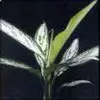 Aglaonema commutatum “Silver Queen”
Aglaonema commutatum “Silver Queen” Aglaonema simplex
Aglaonema simplex Anubias afzelii
Anubias afzelii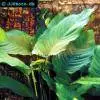 Anubias barteri
Anubias barteri Anubias barteri “Caladiifolia” ‘1705’
Anubias barteri “Caladiifolia” ‘1705’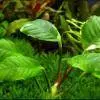 Anubias barteri “Coffeefolia”
Anubias barteri “Coffeefolia” Anubias barteri “Nana”
Anubias barteri “Nana” Anubias barteri v. angustifolia
Anubias barteri v. angustifolia Anubias gracilis
Anubias gracilis Anubias heterophylla
Anubias heterophylla Cryptocoryne affinis
Cryptocoryne affinis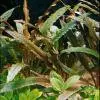 Cryptocoryne albida
Cryptocoryne albida Cryptocoryne balansae
Cryptocoryne balansae Cryptocoryne becketti
Cryptocoryne becketti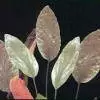 Cryptocoryne blassi
Cryptocoryne blassi Cryptocoryne ciliata
Cryptocoryne ciliata Cryptocoryne cordata
Cryptocoryne cordata Cryptocoryne lutea
Cryptocoryne lutea Cryptocoryne nevillii
Cryptocoryne nevillii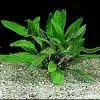 Cryptocoryne petchii
Cryptocoryne petchii Cryptocoryne pontederiifolia
Cryptocoryne pontederiifolia Cryptocoryne wendtii
Cryptocoryne wendtii Cryptocoryne willisii
Cryptocoryne willisii Lagenandra ovata
Lagenandra ovata Pistia stratiotes
Pistia stratiotes Spathiphyllum petite
Spathiphyllum petite Spathiphyllum wallisii
Spathiphyllum wallisii